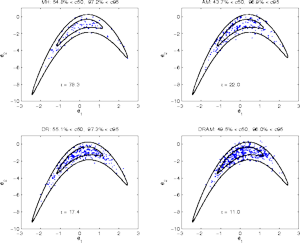
This web page accompanies the article: H. Haario, M. Laine, A. Mira and E. Saksman, 2006. DRAM: Efficient adaptive MCMC, Statistics and Computing 16, pp. 339-354. (doi:10.1007/s11222-006-9438-0). Below, you find some computer experiment using Matlab. More general MCMC Matlab toolbox is available here.
DRAM is a combination of two ideas for improving the efficiency of Metropolis-Hastings type Markov chain Monte Carlo (MCMC) algorithms, Delayed Rejection and Adaptive Metropolis. This page explains the basic ideas behind DRAM and provides examples and Matlab code for the computations. Familiarity with MCMC methods in general is assumed, however.
Random walk Metropolis-Hasting algorithm with Gaussian proposal
distribution is useful in simulating from the posterior distribution
in many Bayesian data analysis situations. For example, in large class
of nonlinear models we can write the model as
In order the chain to be efficient, the proposal covariance must somehow be tuned to the shape and size of the target distribution. This is important in highly nonlinear situations, when there are correlation between the components of the posterior, or when the dimension of the parameter is high. The problem of adapting the proposal distribution using the chain simulated so far is that when the accepted values depend on the history of the chain, it is no longer Markovian and standard convergence results do not apply. One solution is to use adaptation only for the burn-in period and discard the part of the chain where adaptation has been used. In that respect, the adaptation can be tough as automatic burn-in. The idea of diminishing adaptation is that when adaptation works well, its effect gets smaller and we might be able to prove the ergodicity properties of the chain even when adaptation is used throughout the whole simulation. This is the ideology behind AM adaptation. On the other hand, the DR method allows the use of the the current rejected values without losing the Markovian property and thus allows to adapt locally to the current location of the target distribution.
In Adaptive Metropolis, (Haario, et al. 2001) the covariance matrix of the Gaussian proposal distribution is adapted on the fly using the past chain. This adaptation destroys the Markovian property of the chain, however, it can be shown that the ergodicity properties of the generated sample remain. How well this works on finite samples and on high dimension is not obvious and must be verified by simulations.
Starting from initial covariance C0, the target covariance
is updated at given intervals from the chain generated so far.
There is a way to make use of several tries after rejecting a value by using different proposals and keep the reversibility of the chain. Delayed rejection method (DR) (Mira, 2001a) works in the following way. Upon rejection a proposed candidate point, instead of advancing time and retaining the same position, a second stage move is proposed. The acceptance probability of the second stage candidate is computed so that reversibility of the Markov chain relative to the distribution of interest is preserved. The process of delaying rejection can be iterated for a fixed or random number of stages. The higher stage proposals are allowed to depend on the candidates so far proposed and rejected. Thus DR allows partial local adaptation of the proposal within each time step of the Markov chain still retaining the Markovian property and reversibility.
The first stage acceptance probability in DR is the standard MH
acceptance and it can be written as
The smaller overall rejection rate of DR guarantees smaller asymptotic variance of the estimates based on the chain. The DR chain can be shown to be asymptotically more efficient that MH chain in the sense of Peskun ordering (Mira, 2001a). It should also be noted that DR in itself can be applied to much larger classes of problems than those described here.
To be able to adapt the proposal at all you need some accepted points
to start with.
If we combine AM and DR we get method called DRAM
(Haario, et al. 2006). We use different
proposals in DR manner and adapt them as in AM. Many different
implementations of the idea are possible. We demonstrate one quite
straight forward possibility. One "master" proposal is tried
first. After rejection, a try with modified version of the first
proposal is done according to DR. Second proposal can be one with a
smaller covariance, or with different orientation of the principal
axes. The master proposal is adapted using the chain generated so far,
and the second stage proposal follows the adaptation in obvious
manner. In the examples, and in the dramrun Matlab function,
the second stage is just a scaled down version of the first stage
proposal that itself is adapted according to AM.
DRAM is illustrated in the following four examples. Matlab code
for the first 3 examples are given at the end of this
page.
Here is a simple computer experiment to demonstrate all of the four
combinations of the methods. Plain Metropolis-Hastings (MH), Delayed
Rejection (DR), Adaptive Metropolis (AM), and DRAM.
We start with 2 dimensional Gaussian distribution with unit
variances and the correlation between the components equal to
ρ (=0.9 in the example below). Then the Gaussian
coordinates x1 and x2 are twisted
to produce more nonlinear target. The twisting is done with equations
 |
Number τ in the plots is the integrated autocorrelation
time, giving the estimated increase of the asymptotic variance of the
chain based estimates compared to an i.i.d. sample
(Sokal, 1998). Number
τ also varies from run to run, in general DRAM being the
most efficient. Result τ = 11.0 here for DRAM means
approximately that if using every 11. points from the chain, the
sample behaves like an i.i.d. sample from the target distribution.
In this example the target is constructed from a 20 dimensional
Gaussian distribution with singular values of the covariance matrix
diminishing linearly from 10 to 1, thus the condition number of the
covariance matrix is 10. The direction of the first principal axis is
chosen to be [1,1,....,1]'. In addition, the density is
centered at the origin and a positivity constraint is posed. The
positivity is achieved simply by rejecting proposed new values when
any of the coordinates is negative. Upon a reject, a new DR try with a
smaller proposal can be made, however.
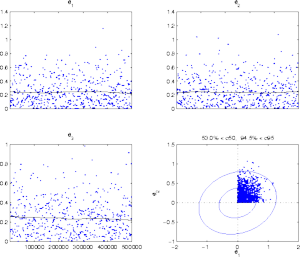 |
A very large number of iterations is needed to get the chain to mix
properly. The picture shows a plot of three first columns of the 20
dimensional chain. Fourth plot is 2d cloud of the first 2 coordinates,
along with correct 50% and 95% contours. We are in a region that has
volume of only 2-20 times the distribution without the
positivity restriction. This a very hard target to make to work
efficiently with plain MH. DRAM seems to handle this situation
correctly.
In this example the target is defined using a likelihood function with
i.d.d. Gaussian errors in the observations. We consider a simple
chemical reaction A<->B, where a component
A goes to B in a reversible manner, with reaction rate
coefficients k1 and k2. The
dynamics are given by the ODE system:
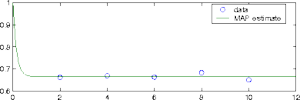 |
Synthetic data is created for parameter values k1 =
2, k2 = 4 at time points t = 2,4,6,8,10.
Zero mean Gaussian noise with standard deviation of size 0.01 is
added. For the prior we set a broad Gaussian distribution with center
point at (2,4) and standard deviation equal to 200 for both
parameters.
 |
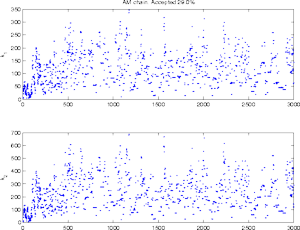 |
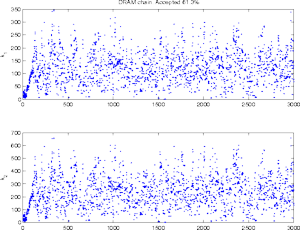 |
In such a low dimensional situation, the chain typically is not
sensitive with respect to the choice of the non-adaptation period,
once the adaptation has properly started. However, if we have to start
with a poor initial proposal, which might not produce accepted points
at the very beginning. Here the initial period and also the
adaptation interval is 100, and we are not able to to produce run
where DRAM would fail.
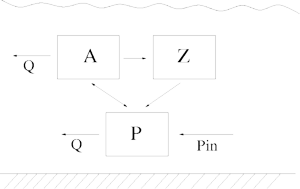 |
The parameters to be estimated are
| μmax | maximum growth rate for A at 20 °C |
| k | half saturation constant for the P demand of A |
| α | the filtration rate for grazing of Z |
| θ | temperature coefficient for A |
| ρa | non predatory loss of A |
| ρz | dying term for Z |
We have observations of the state variables A, Z and P and time series data of the control variables Q, T and Pin.
There are several things to be aware of when estimating this type of models. Firstly, we have to careful with the numerical behaviour of the solvers. During the simulation of the chain, we can get to be in regions of the posterior where the ODE system becomes extremely stiff, for example. Secondly, as some of the parameters are likely to be highly correlated and unidentified by the data, the approaches relying on linearizations of the model might not get realistic approximations of the uncertainties. Even when we use MCMC there might be problems in the convergence of the chain, as seen below.
DRAM is useful in situations where the parameters are not very well
identified by the data. As in the previous example it can happen that
the posterior distributions are "infinite" to some
directions. However, in higher dimensional situations this is not
always clear in advance. Chain generated with fixed proposal can show
very stable behaviour for a long time in a local mode of the posterior,
before starting to explore the whole posterior.
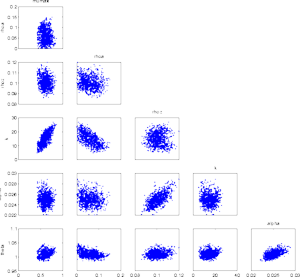 |
At first, at least looking at the 2 d marginal chains, it seems that
the chain has converged and has provided a nice sample from the
posterior. It can be dangerous to rely on too short simulation when
the dimensionality of the parameter is high or the parameters are
correlated.
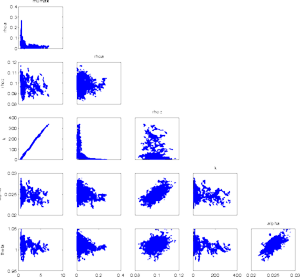 |
Computer code (Matlab 6.x) for the first three examples above are
in a zip file dramcode.zip.
No additional toolboxes are needed to run the code. Some utility
functions for statistical computations are provided.
The main functions and script included are the following.
dramrun.mpriorfun returns always 0. See help dramrun for
more details.
bananatest.mnormaltest.mABrun.m/utils
H. Haario, M. Laine, A. Mira and E. Saksman, 2006.
DRAM: Efficient adaptive MCMC,
Statistics and Computing 16, pp. 339-354.
(doi:10.1007/s11222-006-9438-0)
H. Haario, E. Saksman and J. Tamminen, 2001.
An adaptive Metropolis algorithm
Bernoulli 7, pp. 223-242.
L. Tierney and A. Mira, 1999.
Some adaptive Monte Carlo methods for Bayesian inference.
Statistics in Medicine, 18, pp. 2507-2515.
A. Mira, 2001a.
On Metropolis-Hastings algorithm with delayed rejection
Metron, Vol. LIX, 3-4, pp. 231-241.
P. J. Green and A. Mira, 2001b.
Delayed rejection in reversible jump
Metropolis-Hastings. Biometrika, Vol. 88, pp. 1035-1053.
A. D. Sokal, 1998.
Monte Carlo methods in statistical mechanics: foundations and new
algorithms.
Cours de Troisième Cycle de la Physique en Suisse Romande,
Lausanne.
A. G. Gelman, G. O. Roberts and W. R. Gilks, 1996.
Efficient Metropolis jumping rules, Bayesian Statistics V,
pp. 599-608 (eds J.M. Bernardo, et al.). Oxford University press.